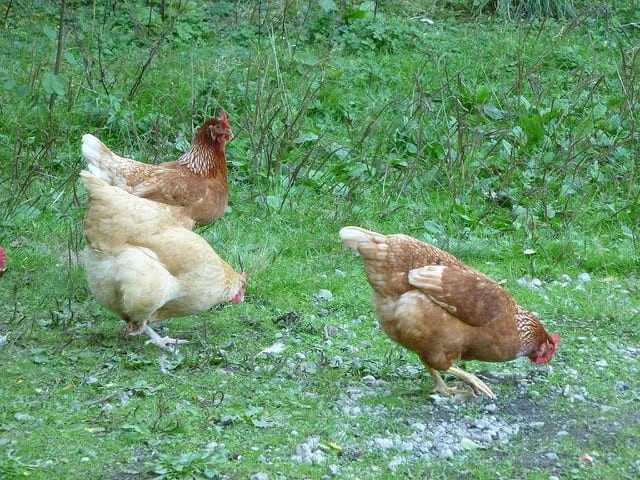Will Harris is the fourth-generation owner of White Oak Pastures, his family's 2500-acre farm near Bluffton, Georgia. When he took over the farm from his father in 1995, it was solely a cattle ranch, utilizing modern, industrial methods to raise livestock. However, Harris wanted a more ‘natural' enterprise, and so began the transition from a modern cattle ranch to an organic, food-producing ecosystem. Today, White Oak Pastures raises cattle, pigs, sheep, goats, rabbits, chickens, turkeys, guinea fowl, ducks, and geese in a system that emphasizes animal welfare and environmental stewardship. Unfortunately, his earth-friendly ambitions have also turned his farm into a gory battlefield between Bald Eagle and chicken.

To be fair to the eagles, it's less of a battle between the two birds and more of a chicken buffet. Harris maintains a flock of about 60,000 chickens, all of which are pasture-raised and are never caged or indoors. About 75 Bald Eagles also live on the farm and Harris estimates each bird kills about four chickens every day; in terms of lost poultry cuts, that is about $1000 every day.

Because of these severe losses, Harris has considered ‘removing' the eagles, though that would go against his earth-friendly farming methods. Even if he wanted to dispose of them, he legally couldn't, as the birds of prey have their own special law: the Bald and Golden Eagle Protection Act. The law prevents the killing, wounding, capturing, harassing and disturbing of Bald Eagles (and Golden Eagles).
While White Oak Pastures supports a healthy (and fattening) population of Bald Eagles, the birds didn't always have it so good. DDT was discovered to be an effective insecticide in 1939, and it became a very popular method of controlling the spread of malaria in the US. It was also effective at killing eagles. This is because, instead of killing an eagle outright, DDT and its breakdown products accumulate in fatty tissues; over time, a bird accumulates enough DDT to alter calcium metabolism. The result is that an eagle begins to lay eggs with thin shells – thin enough that they can no longer support the weight of a nesting parent. By 1963, there were only 417 breeding pairs left in the continental US.

The US government responded to the plight of the Bald Eagles by passing the Bald Eagle Protection Act in 1940 (amended in 1962 to include Golden Eagles) and, in 1978, listing them as ‘endangered' under the Endangered Species Act. The eagles responded to the protections and their populations rebounded; there are about 10,000 nesting pairs today. Bald Eagles were removed from the endangered species list in 2007, though, as a national symbol, they remain protected under the 1940 act.
While good for the eagles, this leaves Will Harris in a bind on how to protect his chickens, which form a large portion of his livelihood. In 2016, the US government granted him a special permit to ‘harass' the eagles. However, a giant inflatable scarecrow, reflective flags, and a sound cannon didn't faze them. They also learned how to get around a giant net placed over the chickens. Harris is recuperating some of his losses through a government program aimed at helping farmers who lose livestock from bad weather or wildlife reintroduction programs. He's even trying his hand at ecotourism by allowing the public to come to his farm and ‘eagle watch' (for a fee, of course).
White Oak Pastures is a good case study in trying to balance nature and human activities. How far should wildlife protections extend? To the point of significantly hampering someone's livelihood? At least for Harris, the Bald Eagles are a sign that he's on the right track to his vision of environmental and agricultural harmony.
About the Author
 A transplant from Virginia (Hoos!), Greg Evans is a graduate student in the Plant Biology department at the University of Georgia studying herbicide and herbivory defenses in morning glories. When he's not tangled up in weeds, Greg enjoys Ultimate Frisbee, bowling, and board games. He can be reached at gevans@uga.edu. More from Greg Evans. A transplant from Virginia (Hoos!), Greg Evans is a graduate student in the Plant Biology department at the University of Georgia studying herbicide and herbivory defenses in morning glories. When he's not tangled up in weeds, Greg enjoys Ultimate Frisbee, bowling, and board games. He can be reached at gevans@uga.edu. More from Greg Evans. |
About the Author
- athenssciencecafehttps://athensscienceobserver.com/author/athenssciencecafe/April 17, 2020
- athenssciencecafehttps://athensscienceobserver.com/author/athenssciencecafe/April 12, 2020
- athenssciencecafehttps://athensscienceobserver.com/author/athenssciencecafe/April 3, 2020
- athenssciencecafehttps://athensscienceobserver.com/author/athenssciencecafe/March 30, 2020







